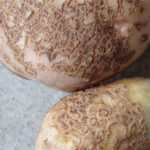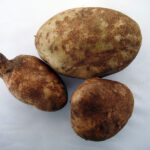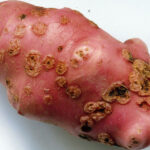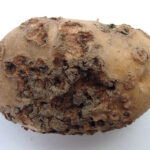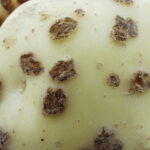Polish name: Parch zwykły
English name: Common Scab
EPPO code: STRESC
Perpetrators of the disease:
- bacteria Streptomyces scabiei (syn. S. scabies)
Gallery
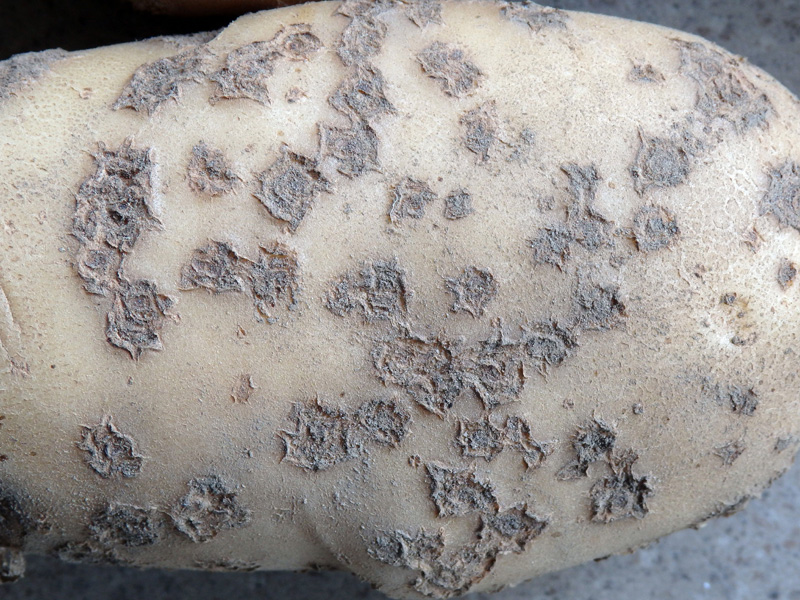
Plain scab of potato. Flat form
(fot. J. Osowski)
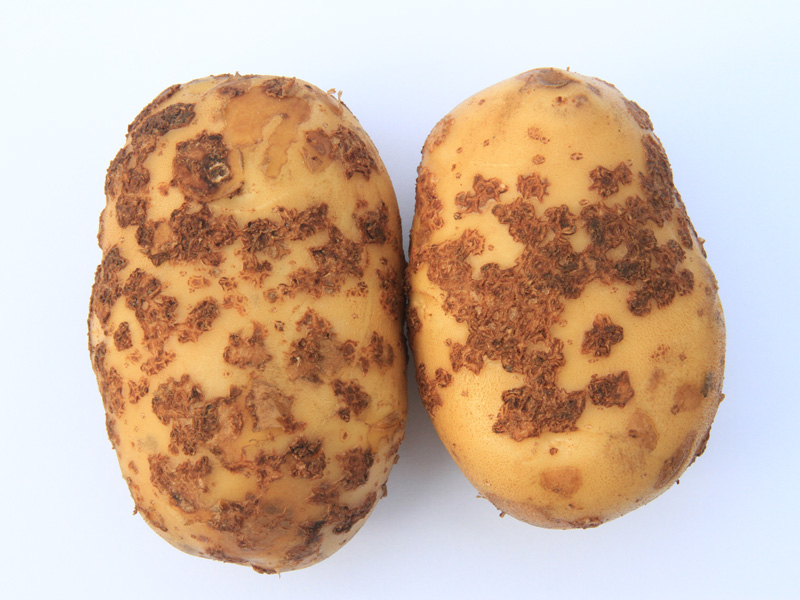
Plain scab of potato. Flat form
(fot. S. Wróbel)
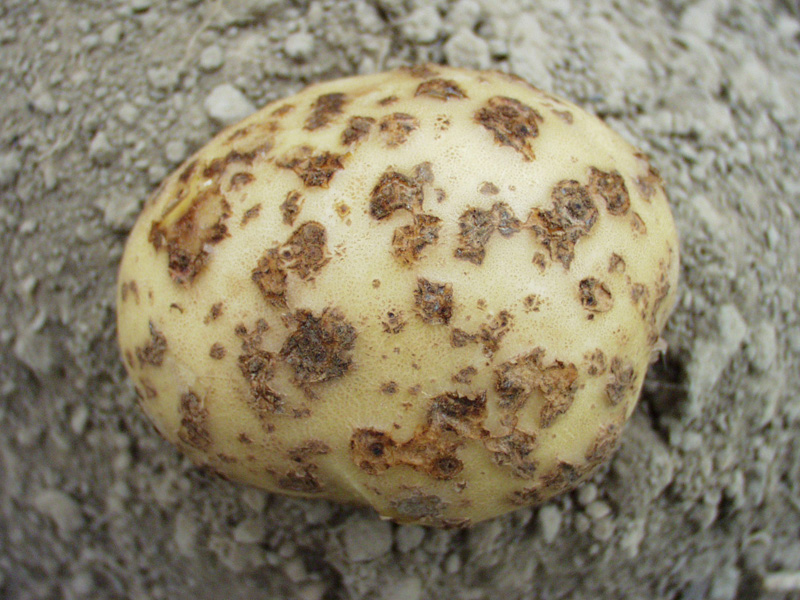
Plain scab of potato. Flat form
(fot. S. Wróbel)
- Parch zwykły ziemniaka. Forma siatkowa (fot. J. Osowski)2
- Parch zwykły ziemniaka. Forma siatkowa (fot. J. Osowski)
- Parch zwykły ziemniaka. Forma wypukła fot. J. Osowski)
- Parch zwykły ziemniaka. Forma wgłębna (fot. J. Osowski)
- Parch zwykły ziemniaka. Forma płaska (fot. S. Wróbel)3
Characteristics and description of the disease
Streptomyces scabiei is the most common species among common scab offenders. Other species associated with this disease are S. acidiscabiei, S. caviscabiei, S. europaeiscabiei, S. luridiscabiei, S. niveiscabiei, S. reticuliscabiei, S. stelliscabiei, and S. turgidiscabiei.
Common scab is the most common disease that damages the skin of potato tubers. It is found in all regions of its cultivation. It lowers the commercial value of edible potatoes intended for food processing and lowers their seed value. Tubers affected by common scab also store less well, because the damaged skin causes water to evaporate faster and it is easier for other pathogens to penetrate.
One of the sources of infection may be diseased seed potatoes. However, the soil population of the pathogen is of greater importance. The frequency and intensity of scab are closely related to the type of soil and its moisture. The common scab perpetrator finds the most favorable conditions for development on light, airy, air-laden soils with moderate humidity. Humidity conditions in the critical period for the occurrence of infection and disease development are also one of the most important pathogens. If there is a shortage of rainfall during this period, and the field water capacity is lower than 75-80%, large tuber infestation may occur.
During the growing season, the appropriate temperature and amount of precipitation in the tuber setting and formation phase, ie from the third decade of May to the third decade of June, are of particular importance for the development of the pathogen. Strong scab infestation is also noted on freshly limed alkaline soils. Bacteria of the genus Streptomyces can grow in slightly acidic to alkaline soils (pH 5.5-8.0). Optimum is pH 6.6-7.2.
Common scab infection of tubers occurs only during the growing season. The perpetrator of the disease enters the tubers through spiracles, stomata, wounds or a young, still poorly developed skin. The most susceptible to infection by scab are tubers from the beginning of formation until they reach about 1 cm in diameter. The disease does not develop during storage and does not cause tuber rot.
Symptoms of paralysis
Symptoms of common scab can appear on various organs of the potato. The most common and loss-making form of the disease is scab on the tuber skin. The first symptoms of the disease are small brown spots, which later form irregular or rounded crusts with a rough surface (this is the cork layer formed by the plant in response to infection). These scabs, depending on the conditions conducive to the development of the disease, may cover part of the tuber or the whole. Depending on the strain of the pathogen, the reaction of the infected cultivar and the environmental conditions, various forms of common scab can be distinguished:
- flat scab – diseased tissue dies only on the surface of the cuticle, and the cork layer separates the formed wound from the healthy flesh (photos 1A, 1B, 1C, 1D)
- scab (deep) – diseased tissue goes deeper and forms furrows and cracks between corky scabs. It is the most dangerous form of the disease (photo 2)
- convex scab – new tissue is formed between the scabs and bulges are formed (photo 3)
- net scab – one of the common scab cultivars, caused by other species of bacteria of the genus Streptomyces (S. reticuliscabies and S. europaeiscabies). The changes on the tubers are superficial (hollows / craters on the surface of the tubers). Young tubers show brown spots that develop in the shape of a reticular cracking in the skin (photos 4A, 4B).
Protection methods
The simplest recommendations are planting healthy tubers, without disease symptoms, and using potato varieties with increased disease resistance on light soils. Differences in the resistance of varieties to the common scab offender are known, but so far there are no fully resistant varieties. In climatic conditions favorable to the development of pathogens, scab symptoms may develop even on more resistant varieties.
Agrotechnical methods are available. One of the most important is rotation, i.e. potato cultivation in the same field no more than every 4-5 years. Use of forecrops unfavorable to scab development, e.g. alfalfa, mustard, lupine, vetches. Liming the soil with carbonate lime is also recommended in forecrop crops. The most favorable period for liming is the post-harvest period. The condition for good operation is, in addition to the dose and form of the fertilizer (for light carbonate lime, for other available forms of fertilizer), its good mixing with the soil. The dose of calcium fertilizers should be determined based on the current pH of the soil and its mechanical composition.
Fertilization with physiologically acidic fertilizers, such as ammonium sulphate, superphosphate, potassium salt, as well as the use of micronutrients such as copper, boron, and especially manganese, can reduce the level of common scab infection. Lowering the pH of the soil with acid or sulfur-containing fertilizers may, however, have a negative impact on the bioavailability of the fertilizers or the size of the yield. In the case of manure, it is most advantageous to apply it in the fall. When it is necessary to apply it in the spring, it must be well processed, because straw is conducive to the development of the perpetrator.
A very important element of protection is the irrigation of fields during the setting and formation of tubers, ie from the third decade of May to the third decade of June. Chemical seed potato treatment or the application of chemical products to the soil can also be used to reduce disease development.
Compiled by: prof. dr hab. Józef Kaps

